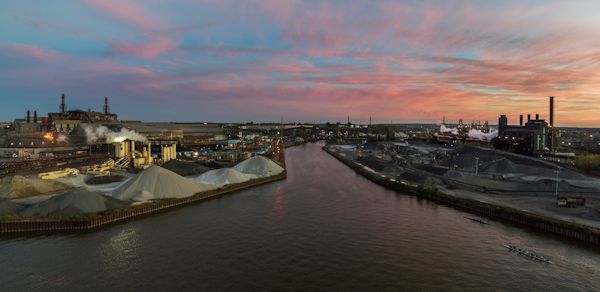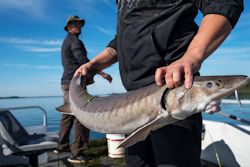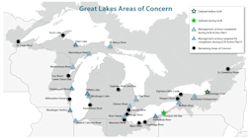SEJournal Online is the digital news magazine of the Society of Environmental Journalists. Learn more about SEJournal Online, including submission, subscription and advertising information.
 |
| Rowers on the Cuyahoga River through Industrial Valley, Cleveland, near the spot where the Cuyahoga River caught fire on June 22, 1969. The resulting news coverage is credited with sparking the modern U.S. environmental movement. Photo: © Peter Essick. Click to enlarge. Plus, click to view more images in Peter Essick's Great Lakes photo essay and get practical advice on learning to fly your own drone. |
EJ InSight: Drones and Photojournalism — Elevating the Craft to New Heights
By Peter Essick
In 1985, as a newly posted summer intern for National Geographic, I photographed a model airplane contest in Massachusetts, resulting in a short story in the magazine. It was the start of a career as a frequent contributor. For the next three decades, I photographed over forty stories for the magazine. It was also my first involvement with an unmanned aircraft system.
By 1993, I was also working on my first environment assignment, photographing a special issue about fresh water. Since then, I’ve covered climate change, nuclear waste, high tech trash, the Canadian oil sands and drought in the western United States, as well as several stories about natural areas around the world. I’ve found working on environmental stories to be challenging, but ultimately very gratifying
Then, four years ago back in my hometown of Atlanta, a unique opportunity to combine the two interests came my way. The Fernbank Museum of Natural History in Atlanta owns the 65-acre tract of urban old-growth forest that it was working to restore and open it to the public. They wanted me to photograph it.
 |
| Members of the Mohawk tribe fish for sturgeon in the St. Lawrence River in Akwesasne territory. They set a nightline with bait and hooks and come back in the morning. They caught five sturgeon on this day. The sturgeon fishery is a traditional food source for the Mohawk tribe. Photo: © Peter Essick. Click to enlarge. |
With the help of a generous donor, the museum commissioned me to photograph their restoration work removing invasive species, as well as the natural beauty of this special Piedmont forest (The results of this project will be published in a book by Fall Line Press in February 2020.)
As part of this project, in order to photograph the forest from above the canopy, I learned to fly a drone. I had often used aerial photography for environmental stories, but I found the low-level perspective from the drone platform to be a new way to show the natural forms of the forest.
It took me a while to learn the intricacies of the technology and to be able to take successful photographs with it (see sidebar). But like most endeavors, practice is the key to better results. So I started to think of other stories, beyond the forest in Atlanta, where the drone could be used for unique and compelling photographs.
Great Lakes restoration a drone-worthy shoot
In 2017, I became interested in doing a story about the restoration of the Great Lakes. I had read an article that the Trump administration had proposed to eliminate almost all of the funding for the Great Lakes Restoration Initiative, or GLRI.
I knew the importance of large-scale ecosystem restoration from previous work in the San Francisco Estuary and the Everglades. The Great Lakes certainly seemed like a worthy subject.
Also, I felt I could use my newfound skill as a drone pilot as a major component for the photography. I applied for and received a storytelling grant from the National Geographic Society to produce the story.
As I continued my research, the importance of the story increased.
I learned that restoration in the Great Lakes began unofficially on June 22, 1969, after the Cuyahoga River in Cleveland caught fire as a result of industrial pollution. Public reaction to the fire contributed to creation of the first Earth Day in 1970, and eventually the beginning of the modern environmental movement in the USA.
In 1987, a treaty was signed between the US and Canada to create “Areas of Concern,” or AOCs, along the Great Lakes. The GLRI was launched in 2010 to accelerate efforts to protect and restore the largest system of fresh surface water in the world.
The federally supported science-based approach is tasked with cleaning up historical pollution, preventing and controlling invasive species, reducing runoff that contributes to algae blooms and restoring habitat to protect native species.
Beyond recreation, long-term goals are to improve water quality to the point where fish are safe to eat and all water is safe to drink.
Making a coverage plan
My plan for the photographic coverage was to use the AOCs as the geographic locations for the project.
Great Lakes cities such as Chicago, Detroit, Cleveland, Duluth and Buffalo offered exciting opportunities for industrial and agricultural landscapes.
The AOCs were usually centered on the rivers and watersheds that fed the Great Lakes where industrial pollution was the most severe and restoration was most needed.
Panoramic and aerial photographs can
portray an overview of modern developments
within a natural environment and
provide a context of human impacts.
I soon learned that the Great Lakes are a large geographic region and I couldn’t cover all of the AOCs with the time and budget that I was allotted. However, I did manage to drive all the way from the St. Lawrence Seaway in upstate New York to the St. Louis River in Duluth, Minn.
I decided to do a drone panoramic photograph of each AOC, which I included in the coverage as an introductory look at the region.
Panoramic and aerial photographs can portray an overview of modern developments within a natural environment and provide a context of human impacts.
Finding launch sites, managing batteries
There were many technical challenges to doing drone photographs.
For example, I wanted to shoot the location where the Cuyahoga River caught fire in 1969. The river is much cleaner now, but this area is still very industrial. It can be difficult to find a place to launch the drone, or even park a car, in these areas that are not on private property. Eventually, I found an abandoned lot under a freeway overpass where I could fly my drone.
 |
| A map of Great Lake “Areas of Concern” for restoration, each of which the author captured in a drone panoramic photograph for his project. Click to enlarge. |
Also, this area of the river is near the Cleveland airport, which until recently was off-limits for flying. Fortunately, a new law allows drone pilots to obtain permission from local airports through a smartphone app, permitting me to fly up to 100 feet altitude to get the photo I wanted.
Another challenge when using a drone in the field is battery management.
This is not a problem when you work from home. You just go out and fly, then come home and charge your batteries overnight. However, when you are traveling every day from hotel to hotel and photographing both at sunrise and sunset, the planning becomes more complex.
For my DJI Inspire 2 drone, I have six pairs of batteries. This allows about one-and-a-half hours of flight time. Since it is legal to photograph up to a half-hour after sunset, my normal procedure would be to find a location and start flying one hour before official sunset. Then I would go back to a hotel and charge my batteries overnight.
In the morning I would get to a new location a half-hour before sunrise, fly another round and rush back to the hotel by 8:00 a.m. It takes three hours to charge the batteries, so I needed to finish by the 11:00 a.m. hotel checkout in order to have charged batteries and be able to fly that evening at a new location. I followed this same routine many times during the fieldwork for this story.
Capturing a ‘special bioregion’
On the ground, I wanted to highlight individuals who were working on restoration projects or who were affected by the current environmental conditions.
The people that I met and photographed offered a similar message — that water quality is much improved in the Great Lakes region, but there is still much work to be done.
Everyone I met also supported the restoration work of this bioregion, a special place for many Americans. Eventually, a bipartisan coalition of legislators from the Great Lakes states came together and worked to continue to fund the GLRI program.
This speaks well of the importance of the Great Lakes Restoration Initiative from the voices of those most affected.
Peter Essick is a photographer, author, speaker, instructor and drone pilot who specializes in nature and environmental themes. Named one of the 40 most influential nature photographers in the world by Outdoor Photography Magazine UK, Essick is the author of two books of his photographs, “The Ansel Adams Wilderness” and “Our Beautiful, Fragile World.” His Great Lakes story appeared in March 2019 in the online science journal Undark, a publication of the Knight Science Journalism Fellowship Program at MIT.
[Editor's Note: Peter Essick’s Great Lakes coverage included a range of images, both from drones and on the ground, to help tell the story of the restoration effort. View a selection in the Flickr slideshow below. Click on the arrow to view images on this page, or click the image to open a full-sized slideshow with full captions. Plus, in a sidebar, Essick gives practical advice on learning to fly your own drone.]
* From the weekly news magazine SEJournal Online, Vol. 4, No. 41. Content from each new issue of SEJournal Online is available to the public via the SEJournal Online main page. Subscribe to the e-newsletter here. And see past issues of the SEJournal archived here.















 Advertisement
Advertisement 



